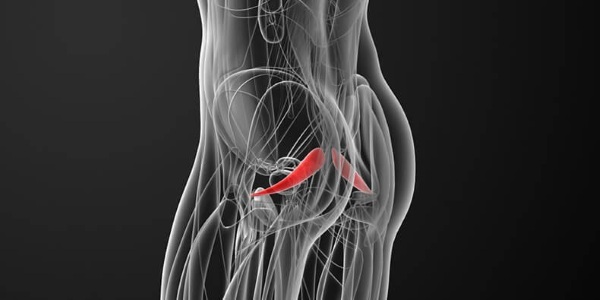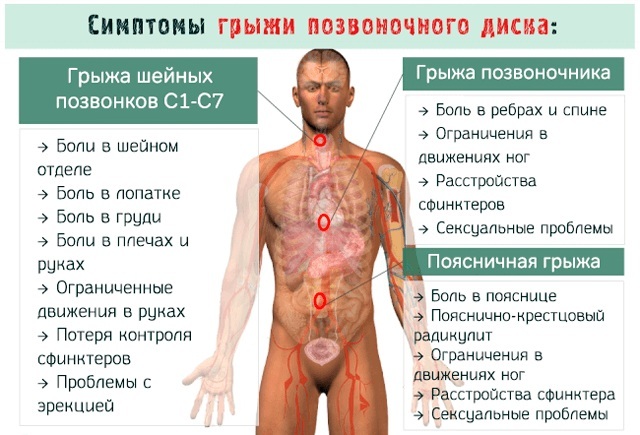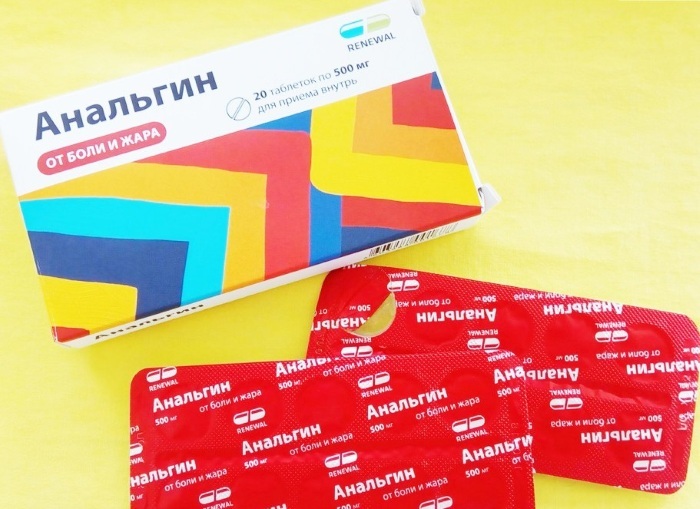Scoliosis is a lateral deformity (rachiocampsis. Pathology can be corrected if the disease is detected in the early stages, when the curvature angle is no more than 15-25 degrees.
Record content:
- 1 Views
- 2 Stages and degrees
- 3 Symptoms
- 4 Reasons for the appearance
- 5 Diagnostics
- 6 When to see a doctor
- 7 Prophylaxis
-
8 Treatment methods
- 8.1 Medications
-
8.2 Traditional methods
- 8.2.1 Salt compress
- 8.2.2 Potato compress
- 8.2.3 Back massage with honey
- 8.3 Wearing a corset
- 8.4 Massage
- 8.5 Manual therapy
- 8.6 Physiotherapy
- 8.7 Physiotherapy
- 8.8 Operation
- 9 Possible complications
- 10 Scoliosis video
Views
Scoliosis of the spine (degrees by degrees express the stage of pathology) has a large number of classification types and varieties:
| By etiology (origin) | |
| Congenital | It develops as a result of an abnormal structure of the spinal column and nearby musculoskeletal structures. |
| Acquired | It develops as a result of past diseases and injuries. |
| Idiopathic | It develops for no specific reason. |
| By the nature of the changes | |
| Structural | It proceeds with twisting of the vertebrae. |
| Non-structural | It develops without twisting the vertebrae. |
| Due to the occurrence | |
| Posture | Occurs as a result of posture disorders. |
| Reflex | It occurs during forced postures that the patient takes due to severe back pain. |
| Compensatory | Appears due to the different lengths of the legs (since one side of the body must be tilted to compensate for the different lengths). |
| Hysterical | It appears as a result of psychogenic trauma. |
By the shape of the curvature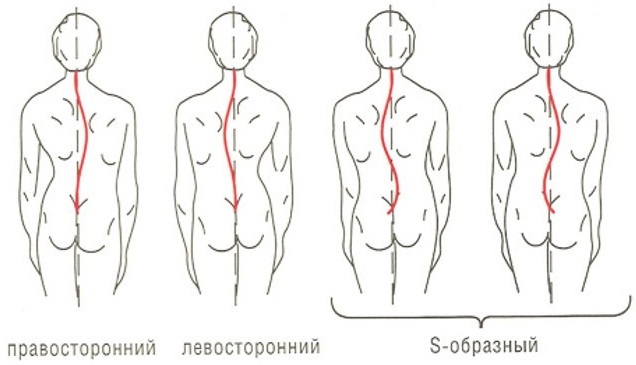 | |
| C-shaped | There is only one arc of curvature. |
| S-shaped | There are 2 arcs of curvature. |
| Z-shaped | There are 3 arcs of curvature. |
| With the flow | |
| Stable (non-progressive) | The angle of curvature of the spine remains at the same level for a long time. |
| Progressive | Scoliosis progresses rapidly and the arch of the curvature increases. |
By localization, right-sided and left-sided scoliosis are distinguished.
Curvature can occur in any part of the spinal column, so scoliosis also happens:
- cervical;
- cervicothoracic;
- chest;
- thoracic-lumbar;
- lumbar;
- lumbosacral.
Stages and degrees
Scoliosis has 4 degrees of curvature of the spinal column, determined by degrees:
- At the first stage, the curvature angle is no more than 10 degrees, changes in the structure of the spine are noticeable only when tilted. Slight asymmetry in the shoulder line and stoop are possible.
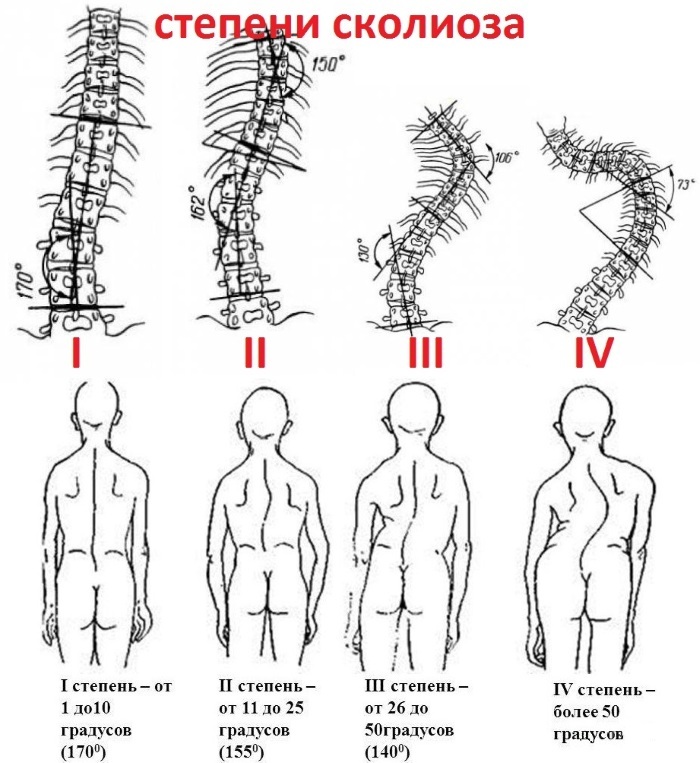
- The curvature angle in the second stage is 11-25 degrees. The asymmetry of the shoulder line and the waist triangles becomes more noticeable. The patient begins pain in the back, posture and gait are disturbed.
- At the third stage, the curvature angle reaches 26-50 degrees. The deformation is pronounced, a hump is formed. Violations of the internal organs begin.
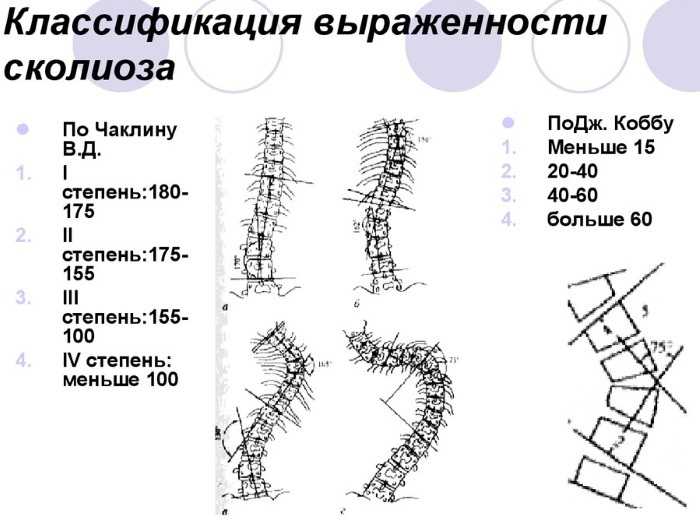
Scoliosis of the spine. Degrees by degrees according to Cobb, Chaklin - At stage 4 of scoliosis, the curvature angle is more than 50 degrees, there are severe organ dysfunctions, gait changes greatly, household habits and quality of life deteriorate.
Symptoms
The symptoms of scoliosis vary depending on its location:
- Cervical scoliosis - there is a slight asymmetry of the shoulders, headaches, possibly impairment of memory and attention (since due to curvatures, blood vessels and nerves leading to the brain are compressed and the nervous system deteriorates systems); there may also be a feeling of muscle "pinching" in the neck.
- Cervicothoracic andthoracic scoliosis - there is an unequal level of the shoulder blades, curvature of the chest; shortness of breath is manifested.
- Thoracic-lumbar,lumbar and lumbosacral scoliosis - there are pains in the lower back and limited mobility of the back, visual changes are almost imperceptible; men may have problems with potency, women - with libido and menstrual cycle.
In the early stages of the disease, there are no symptoms from the internal organs, there are only back pain and small visual changes.
Reasons for the appearance
Scoliosis of the spine (degrees by degrees can only be determined using instrumental diagnostic methods) appears due to the following reasons:
- improper posture while standing and sitting;
- weakness of the muscles of the back and abs;
- congenital pathologies of the structure of the spinal column, limbs;
- spinal injury;
- passive lifestyle;

- obesity (most often obesity leads to scoliosis of the lumbosacral region, due to the fact that it “supports” a large body weight and the load on it increases);
- rickets;
- degenerative-dystrophic diseases of the spine;
- malignant formations in the spine;
- flat feet (due to flat feet, the load on the back and spine is unevenly distributed, which can cause curvature).
Diagnostics
If you suspect scoliosis, you should consult an orthopedist or vertebrologist. The specialist collects anamnesis (whether there were spinal injuries, whether there are diseases of the musculoskeletal system and other data) and conducts a visual examination of the patient, taking into account the following parameters:
- symmetry of the shoulders, shoulder blades, waist triangles, pelvic bones;
- the presence of a hump;

- the length of the arms and legs;
- mobility of the vertebrae and joints;
- the level of muscle tone;
- the presence of lordosis and kyphosis;
- the level of curvature when leaning forward and down;
- the level of curvature in the supine position;
- the presence of flat feet.
As an additional diagnosis, an X-ray of the spinal column is prescribed, which makes it possible to identify the angle of curvature and the presence of certain diseases that can cause scoliosis.
X-ray examination is carried out in several planes: in the standing position of the patient, lying straight and lying on his side.
If the results of radiography are blurred, computed tomography (CT) or magnetic resonance imaging is prescribed tomography (MRI), with the help of which you can see in more detail the spinal column and nearby structures.
Additionally, consultations of other specialists (traumatologist, neurologist) may be required to determine the exact causes of the development of pathology or in the presence of symptoms from the nervous system.
When to see a doctor
Early diagnosis and treatment of scoliosis (especially in childhood and adolescence) will help prevent the progression of pathology and complications from internal organs and muscle structures.
It is quite difficult to notice scoliosis at the very beginning of its development, since there are almost no symptoms, and visual changes are noticeable only if you look at the person from behind. Since the main symptom of scoliosis is back pain, when it develops, it is necessary to consult an orthopedist as soon as possible in order to exclude or confirm the diagnosis.
It is easier for adults to detect scoliosis in children - the child often slouches, and he has a slight asymmetry of the shoulders or shoulder blades. In no case should you start self-medication with corsets and other methods, but you should visit a pediatric orthopedist in order to start treatment of scoliosis in a timely manner.
Prophylaxis
Scoliosis of the spine (degrees by degrees increase if medical recommendations are not followed) can be prevented by observing the following rules:
- it is necessary to monitor your posture and the posture of the child when walking, standing and sitting;
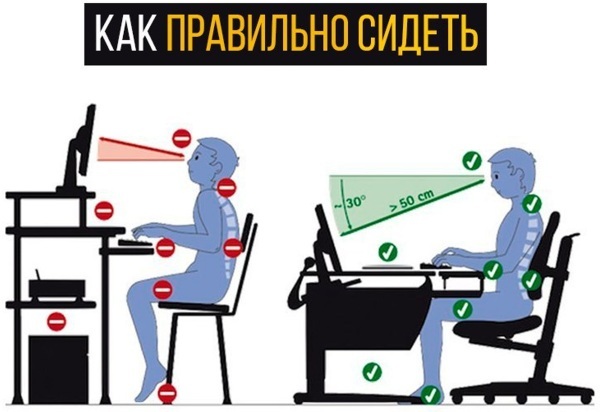
- sleep on a flat surface (preferably on a hard or orthopedic mattress);
- monitor weight and prevent obesity;
- eliminate hypodynamia, move more and engage in physical activity (ride a bike, swim, play outdoor games);
- evenly distribute the load on the back when playing sports, do not carry weights on the shoulders and back;
- for sedentary work, it is recommended to choose a comfortable chair with a backrest and adjust its height so that the table is approximately at the level of the solar plexus; also when sedentary work, it is advisable to get up every hour and do a little exercise of 2-3 exercises to stretch the back;
- eat a balanced diet (the diet should contain a variety of foods rich in vitamins of all groups and minerals);
- do yoga, as it helps to improve the health of the spine;
- strengthen the muscles of the back and abs (as they support the spine);
- in the presence of flat feet, wear special instep supports or orthopedic insoles (to evenly distribute the load on the spinal column);
- prevent the progression of degenerative-dystrophic diseases of the spine and other elements of the musculoskeletal system, follow all the doctor's recommendations during treatment.
Prevention of scoliosis in children includes the above recommendations, as well as the correct selection of a backpack for school (with two straps and orthopedic backrest for uniform loading), playing sports or dancing and an equipped workplace, depending on age and height child.
Also, you can not sit an infant earlier than 7-8 months and until the moment when the child begins to make independent attempts to sit.
Treatment methods
Scoliosis treatment includes various methods and, if necessary, the use of drugs and the use of folk recipes. In severe cases, surgery is performed.
Also, treatment is aimed at eliminating the causes of the curvature. With weakness of the back muscles, measures are prescribed to strengthen them; with obesity, a decrease in body weight is shown; with flat feet, it is necessary to wear orthopedic insoles.
Medications
In the presence of painful sensations in the back, pain relievers are prescribed in the form of tablets or injections, less often - ointments and gels. Effective drugs for eliminating back pain are: Diclofenac, Ketanov, Ibuprofen.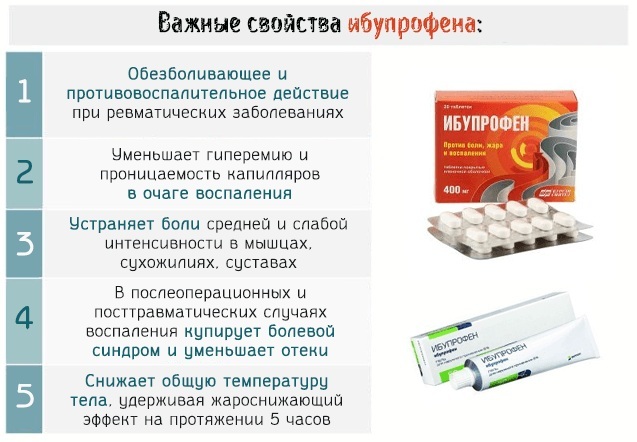
If conventional painkillers do not help, then Novocaine injections are prescribed. In the last stages of the pathology, when the pain becomes unbearable, narcotic analgesics can be prescribed.
Since scoliosis leads to pinching of blood vessels and nerves and, consequently, disturbances in the functioning of the nervous system, then the patient is prescribed preparations of B vitamins (in tablets or injections) as an additional strengthening funds.
Also, calcium and vitamin D3 preparations are prescribed separately or in combination to strengthen bone tissue (Calcium-D3 Nycomed, Calcemin Advance, Aquadetrim).
Traditional methods
It is impossible to correct the curvature of the spine using folk methods. However, with their help, you can eliminate some of the symptoms of pathology, such as pain and stiffness.
Salt compress
The saline compress helps to relieve soreness and improve back mobility. Dissolve 25 g of table or sea salt in a glass of hot water and stir. Then, a gauze or a piece of cloth should be moistened in the solution and applied to the affected area for 1.5-2 hours. At this time, you should lie quietly so that the bandage does not sleep.
Potato compress
Potato compress has a more pronounced analgesic effect than saline, so it should be used for severe pain.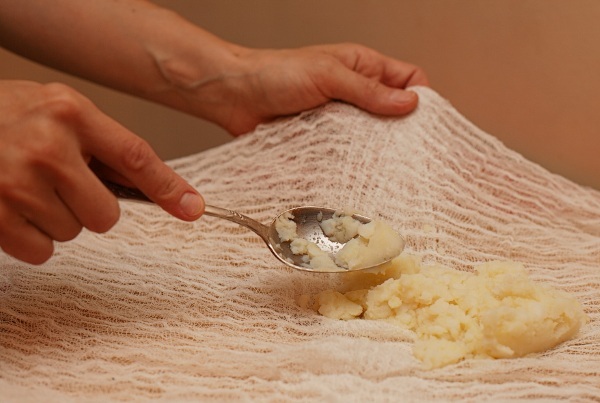
To prepare the product, you must:
- Boil and chop 1 potato until puree.
- Put the resulting gruel in a warm form on the sore area, cover it with plastic wrap and wrap it with a towel or a warm scarf (shawl).
- The compress should be kept for 1-1.5 hours, then removed from the back.
Back massage with honey
The procedure allows you to get rid of painful sensations and improve back mobility by improving blood circulation in the target area. You can do the neck or lower back massage yourself, but to massage the thoracic spine, you will need to ask someone else to do the procedure.
For massage, 1 tbsp is enough. l. any liquid honey, which must be gently smeared with massage movements over the affected area. Movements should be light, you should not put pressure on parts of the body. The duration of the procedure is 5-7 minutes. After that, you need to wash off the honey from the skin and wrap the worked area for 30-40 minutes.
Honey massage is recommended every other day. The number of procedures is 10.
Wearing a corset
The brace helps to correct the position of the spine, to give it a physiological position and to stop the progression of scoliosis. There are different types of corsets, which are selected by the doctor depending on the age, the angle of curvature, and the patient's lifestyle. The duration and duration of wearing is prescribed individually.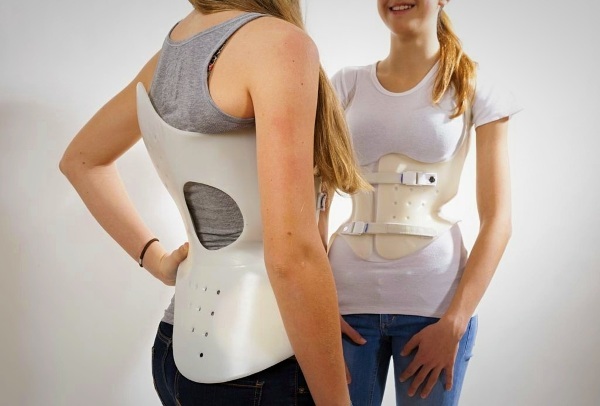
Also, wearing a corset helps relieve tension from the back and evenly distribute the load on the spine.
Massage
The massage is effective both for scoliosis (stages 1 and 2) and for its prevention.
It contributes to:
- elimination of shallow muscle clamps;
- normalization of blood circulation and lymph flow in the back;
- improving tissue nutrition;
- relieving tension and spasm of the back muscles;
- correction of the position of the spine.
The massage should be performed by an experienced specialist, preferably specialized in diseases of the spine. When treating children, it is necessary to contact a pediatric masseur, as he knows the structural features of the child's body.
The recommended course of treatment is 10-15 procedures 2 times a year.
Manual therapy
With the help of manual therapy, it is possible to remove the clamps of the muscles and vertebrae, which can cause the curvature, and give the spine the correct position (if the curvature angle is small).
Manual therapy techniques are similar to massage, however, a manual therapist acts on the musculoskeletal structures and vertebrae at a deeper level. To correct the deformity of the spine, 1-3 sessions are sufficient.
Physiotherapy
Physiotherapy procedures enhance blood circulation and tissue nutrition, relieve pain, improve spine mobility and further strengthen the back muscles.
With scoliosis, the following procedures may be prescribed:
- electrophoresis with the introduction of anesthetic drugs, vitamins or chondroprotectors (if there are degenerative-dystrophic pathologies of the spine);
- electrical stimulation of the back muscles;
- magnetotherapy;
- thermotherapy (paraffin or ozokerite applications);
- water procedures (hydromassage baths, Charcot shower, circular shower).
Physiotherapy
Physiotherapy is a mandatory part of the treatment of scoliosis. Special exercises are aimed at strengthening the muscles of the back and abs (to create a strong muscular corset that can support the spinal column), relieve spasms, and stretch the spine.
Therapeutic gymnastics is practiced in the clinic, where the instructor shows the correct technique and sequence of exercises. Later (after 10-12 sessions), therapeutic exercises can be done at home. It is recommended that you exercise daily and make it a habit (for example, doing it as a morning exercise) to keep your spine healthy.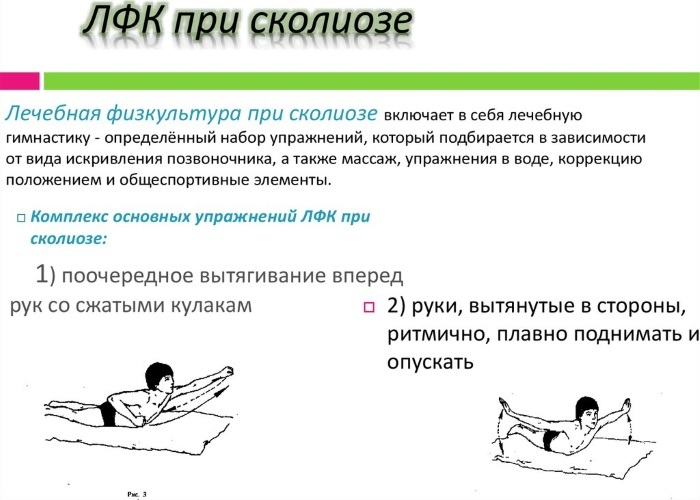

The exercise therapy program for the treatment of scoliosis includes exercises while standing, sitting, lying down, near the wall bars and on a fitball. Exercises with a gymnastic stick are also effective. As exercise therapy, you can engage in swimming, which very well helps to relieve the spine and strengthen all the muscles of the body.
A contraindication to exercise therapy is scoliosis of 3 and 4 degrees, when there are serious violations of the organs and severe deformities of the spine. In this case, exercise can harm and aggravate the situation.
Operation
Scoliosis of the spine (degrees by degrees are measured using special techniques) is treated surgically in the following cases:
- if the angle of curvature is more than 45 degrees;
- pathology interferes with the normal functioning of organs and worsens the quality of human life;
- conservative methods of treating scoliosis are ineffective and the disease progresses;
- there is a strong persistent pain syndrome;
Also, the decision to carry out the operation is made depending on the patient's age, contraindications, localization of the curvature and the state of the patient's general health.
The essence of the surgical intervention is to straighten the spinal column to a certain angle and fix it with the help of special metal structures. At the same time, the fixed part of the spine becomes immobilized. After the operation, the patient undergoes a long course of recovery, and he is also shown a spa treatment.
Possible complications
Curvature of the spinal column leads to grazing and pinching of nerves, blood vessels, compression and change in the position of internal organs.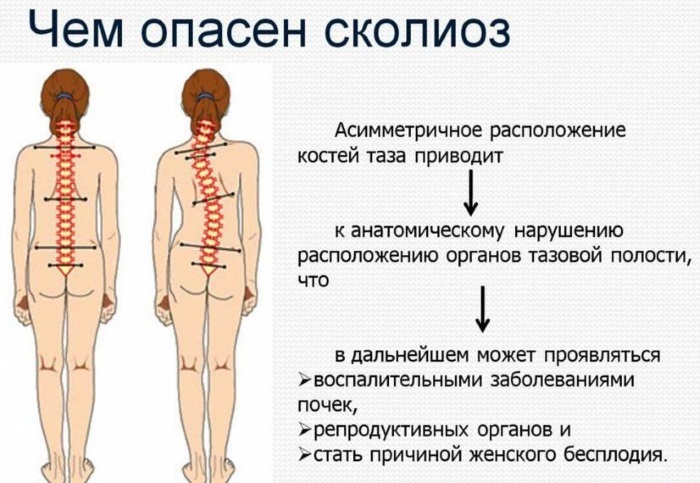
Therefore, scoliosis in the absence of therapy can lead to the following complications (depending on the location):
- Cervical scoliosis: deterioration of attention and memory, vision, hearing due to cerebral circulation disorders;
- Cervico-thoracic, thoracic and thoracic-lumbar scoliosis: disruption of the heart and lungs, the digestive system, the formation of a hump and torticollis;
- Lumbar and lumbosacral scoliosis: constipation, urination disorders, impotence, gynecological diseases, gait disorders, edema of the lower extremities.
If the disease progresses and greatly impairs the quality of a person's life (if his everyday skills deteriorate, he cannot work normally, he cannot walk), then they give disability.
The most favorable prognosis for the treatment of scoliosis in childhood and early adolescence, when you can correct the deformity or stop its progression using a corset and a medical physical education.
Scoliosis is a common and dangerous disease of the spine, the degree of which depends on the degree of curvature. It can lead to serious complications, so it is important to notice the symptoms of deformity in time and consult an orthopedist.
Scoliosis video
Malysheva on scoliosis:

